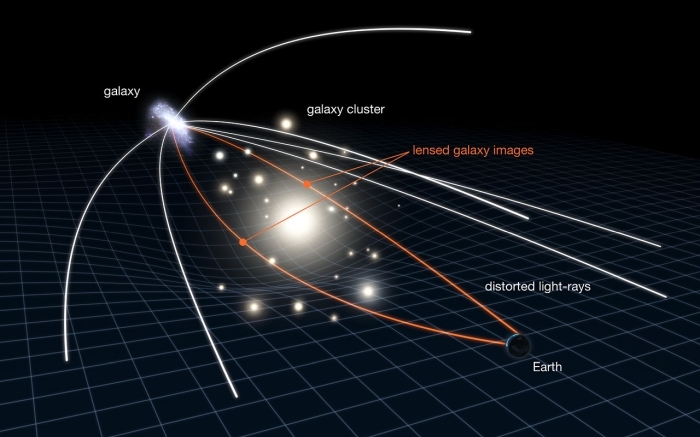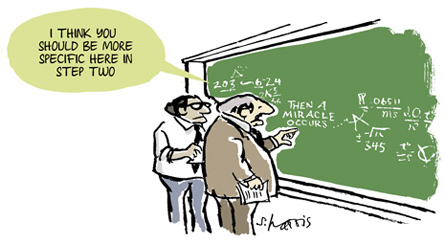
Posted on 09/11/2020 10:56:00 AM PDT by Red Badger
It would be extremely optimistic to suggest that we have a good handle on dark matter. But even the slight grasp we do have may be missing something important.
New observations from the Hubble Space Telescope have found much higher concentrations of dark matter than expected in some galaxies, by over an order of magnitude.
These concentrations are inconsistent with theoretical models, suggesting that there's a big gap in our understanding - the simulations could be incorrect, or there could be a property of dark matter we don't fully understand, according to the research team.
"We have done a lot of careful testing in comparing the simulations and data in this study, and our finding of the mismatch persists," said astrophysicist Massimo Meneghetti of the National Institute for Astrophysics in Italy.
"One possible origin for this discrepancy is that we may be missing some key physics in the simulations."
Dark matter is one of the biggest thorns in our understanding of the Universe. Simply put, we don't know what it is. It does not absorb, reflect, or emit any electromagnetic radiation, making it completely undetectable in a direct way. However, it does interact with the Universe's visible matter via gravity.
This means we can study how things like galaxies and stars are distributed and move around the Universe, calculate the gravity required to produce those distributions and movements, and calculate and subtract the gravity produced by the visible matter.
The gravity that's left indicates how much dark matter is in the Universe - and, from what we can tell, it's a lot. As much as 85 percent of the matter in the Universe could be dark matter.
One of the ways we can indirectly 'detect' dark matter is through gravitational lensing. Really massive objects, like clusters of galaxies, create such an intense gravitational field that spacetime itself curves - which means any light travelling through that spacetime moves on a curving path.
So, objects on the far side of that gravitational field, such as distant galaxies, appear to us magnified, smeared, duplicated, and distorted.

Gravitational lensing. (NASA, ESA & L. Calçada)
==============================================================================
By studying these distortions and putting the galaxies back together, we can figure out how the light was distorted, which means we can map the gravitational field - the bigger the distortion, the stronger the gravitational field. Once again, subtract the visible matter, et voila - a map of the dark matter within that lensing cluster. It's mind-blowingly clever.
And that's what Meneghetti and his team were doing, looking at observations of 11 galaxy clusters using the Hubble Space Telescope and the European Southern Observatory's Very Large Telescope in Chile.
"Galaxy clusters are ideal laboratories to understand if computer simulations of the Universe reliably reproduce what we can infer about dark matter and its interplay with luminous matter," he explained.
When the team sat down to analyse the data, they found the large-scale lensing effects as expected to be produced by the galaxy as a whole. But they also found smaller lensing effects nested inside. These small lenses, produced by individual galaxies within the clusters, did not appear in simulations of the clusters, suggesting an excess of dark matter.
To check their findings, the team conducted spectroscopic observations of the galaxies, using the shift of light to calculate the velocity of the orbiting stars - a classic tool for measuring dark matter.
And they double-checked their distance calculations, because that can make a crucial difference to dark matter calculations.
The researchers found that there's a much greater concentration of dark matter in those individual galaxies than the simulations allowed for. But the simulations were based on our best understanding of dark matter - so where does the additional mass come from?
Well, we don't know. But it's going to be an exciting journey of discovery.
"To me personally, detecting a gnawing gap - a factor of 10 discrepancy in this case - between an observation and theoretical prediction is very exciting," said astrophysicist Priyamvada Natarajan of Yale University.
"A key goal of my research has been testing theoretical models with the improving quality of data to find these gaps. It's these kinds of gaps and anomalies that have often revealed that either we were missing something in the current theory, or it points the way to a brand-new model, which will have more explanatory power."
Either way, discovering what's causing the discrepancy between simulation and observation is likely to lead us to a stronger understanding of dark matter.
The research has been published in Science.
Full cover image credit: NASA, ESA, G. Caminha (University of Groningen), M. Meneghetti (Observatory of Astrophysics and Space Science of Bologna), P. Natarajan (Yale University), the CLASH team, and M. Kornmesser (ESA/Hubble)
Dark matter matters.

Black Matter Lives......................
What matters is that we’re still in the dark about dark matter. Consider the gravity of that.
By the way, does anyone know what the Speed Of Dark is?
Is it something to do with Biden's Brain?
Anytime you hear the word “dark” in science, you should immediately be suspicious.
“Dark matter”....”Dark energy”.....maybe neither exist. Maybe our current understanding is simply flawed and that’s why our models don’t work. As brilliant as Newton was, he got some things wrong as Einstein pointed out. Well as brilliant as Einstein was maybe.......
Or maybe it doesn’t exist at all. After all, there’s only indirect evidence for it, right?
You’re always missing physics in simulations that’s why its a simulation !
We are so limited in what we know, and what we can measure, it’s like trying to teach a chimpanzee calculus.
“We don’t know what it is.”
Huh.

I’m still waiting for proof that there’s matter that is undetectable, that doesn’t reflect light, and that doesn’t just satisfy some equations that would not work without it.
It should go without saying...but...you know this is racist!
Is dark matter and dark energy the epicycles thingee all over again?
Be light, and there was light.
What is known fills one page in one book. What is unknown fills infinite volumes of books in infinite libraries
Galactic motions aren’t consistent with the amount of observable matter. So either the basic theory is wrong or there is a lot of undetectable matter and energy in the universe. Since theory can’t ever be wrong there must be invisible, undetectable matter that affects everything.
Think about that for a minute. LOL. Most of the universe is made up of undetecable, invisible matter and energy. You have to believe this because they all have so many college degrees.
Has any scientist ever proposed that our universe is expanding faster over time because there is unseen matter that it is falling towards that has not been detected yet?
Disclaimer: Opinions posted on Free Republic are those of the individual posters and do not necessarily represent the opinion of Free Republic or its management. All materials posted herein are protected by copyright law and the exemption for fair use of copyrighted works.